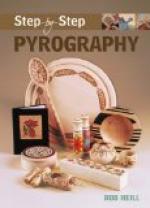The room had been much the same for more than a hundred years, the castle having been built during the tenth century. The thing that made it Lady Philippa’s own particular room, which could have belonged to no one else, was the set of soft yet brilliant tapestries which covered the walls. They had been worked by her in her girlhood, and she sometimes felt that more than half her life was wrought into the quaint figures and innumerable flowers and leaves and emblems of those narrow panels of embroidery. They had adorned the room which had been hers in her father’s castle, and single panels had curtained or covered wall-spaces in many other castles during her life as Queen Eleanor’s maid of honor. Little Eleanor had heard the story of the pictures as soon as she was old enough to hear stories at all, and there was some story connected with the making of each part of the set. It presented in a series of scenes the history of Sainte Genevieve of Paris. In the first picture she was shown as a little girl tending her sheep; then there were pictures of her at the various exciting times in her life—her saving the people from the Huns, her staying of the plague, her audience with King Clovis and finally her peaceful old age among the people who loved her.
Eleanor was kneeling on the window-seat where she sometimes slept, her bright braids falling over her white linen underdress and gown of soft blue wool. “Mother,” she said earnestly, “I wish I could make some tapestry.”
Lady Philippa was deftly drawing together the edges of a rent in an old and magnificent gold-embroidered bed-curtain. “Have you finished your spinning, daughter?” she asked.
“N-o, but it is almost done. Mother, I will spin twice as much every day if you will teach me to do tapestry. Were you older than I am when you learned?”
“Not very much older. Perhaps you might begin now. Finish your task while I make this curtain whole, and we will see.”
When her mother said she would “see,” Eleanor knew that a favor was as good as granted. She spun away to a happy little song that Collet, her mother’s maid, had taught her, and very soon the good linen thread was all wound smoothly and the little spinster sat demurely watching the preparations for her new undertaking.
First her mother opened the wardrobe chest and took out a strip of linen about twenty inches wide and of a brownish cream-color. Next she selected some skeins of dyed linen thread from a heap of all the colors of the rainbow, mementoes of the work her busy fingers had done during many years. In a little enameled box, very carefully wrapped in soft wool to keep them from rusting, were a few needles. Out of a wrapping of cotton paper came a thin stick of charcoal rather like a crayon—charred hard wood that could be used for drawing.
“Now,” said the lady smiling at the eager little face, “what shall we choose for the subject of your tapestry, and what is to be its use? Will you have it for a cushion, or a panel of a screen, or something else?”




